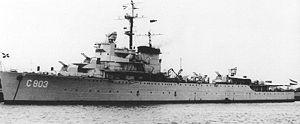HNLMS Jacob van Heemskerck (1939)

| |
| History | |
|---|---|
| Name | Jacob van Heemskerk |
| Builder | Nederlandsche Scheepsbouw Mij., Amsterdam; completed in British yard |
| Laid down | 31 October 1938 |
| Launched | 16 September 1939 |
| Completed | 10 May 1940 |
| Commissioned | 16 September 1939 |
| Decommissioned | 20 November 1969 |
| Stricken | 27 February 1970 |
| Fate | Sold for scrap, 23 June 1970 |
| General characteristics | |
| Type | Light cruiser |
| Displacement | 4,000 long tons (4,064 t) standard |
| Length | 1,325 m (4,347 ft 1 in) |
| Beam | 12.4 m (40 ft 8 in) |
| Draught | 4.8 m (15 ft 9 in) |
| Propulsion | list error: <br /> list (help) 2 Parsons geared steam turbines 4 Yarrow boilers 2 shafts 56,000 shp (41,759 kW) |
| Speed | 32.5 knots (37.4 mph; 60.2 km/h) |
| Complement | 393 or 420 |
| Armament | list error: <br /> list (help) • 10 × 102 mm (4 in) guns (5×2) • 8 × 40 mm (4×2) • 8 × 20 mm AA guns • 2 × depth charge rails |
| Armour | list error: <br /> list (help) Belt: 2–2.5 in (51–64 mm) Deck: 1.5 in (38 mm) |
HNLMS Jacob van Heemskerck was a Tromp-class light cruiser of the Royal Netherlands Navy, named after Admiral Jacob van Heemskerk (1567–1607).
Originally designated as a flotilla leader and a torpedo cruiser in Decker's Fleet Plan of 1931, she was hastily commissioned on 10 May 1940, when Germany invaded the Netherlands. However, as she was not armed she escaped to the UK, she was refitted as an air defence cruiser, since these were the only type of gun available, and there was a growing need for this type of ship to protect the convoys. During the war the crew felt that their ship was blessed and gave her the nickname Oude Jacob (Old Jacob). She received the reputation that not a single convoy ship would be lost when she was on duty.
Service history
The ship was meant to commence trials on the day the Germans invaded and to prevent her capture was immediately pressed into service. Since she had no armament she left port for the United Kingdom with only a skeleton crew. Once she had arrived in Portsmouth attempts were made to give her weaponry of some sort. She received the depth charge equipment from the old torpedo boats G13 and G15. On 18 May 1940, Queen Wilhelmina paid the ship a visit. At the end of the month, Heemskerkand and the aging cruiser HNLMS Sumatra received the assignment to transport Princess Juliana and her two children (including the Crown Princess) to Canada. The ships put to sea on 2 June and arrived on the 11th at Halifax.
The Heemskerck returned alone to England and arrived at Portsmouth in July where her re-arming program began. The British Admiralty decided to convert her to an anti-aircraft ship. Work was completed on 17 February 1941, and after sea trials, which lasted till 29 February, the ship was assigned as convoy escort in the Atlantic Ocean as part of the Irish Sea Escort.
She was removed from escort duty in January 1942 and sent to the Dutch East Indies to reinforce the defence fleet assembled there. The ship arrived to late too take part in the battle of the Java Sea and was re-assigned to the Eastern Fleet in 1942. In September 1942 the ship took part in operations 'Stream' and 'Jane', both aimed at the retaking of Madagascar. On 25 October Heemskerck arrived at Fremantle, Australia, and came under the command of Allied Naval Forces Western Australia, where she performed convoy duties.
On 28 November 1942, Heemskerck in the company of the Australian cruiser HMAS Adelaide, identified and damaged the German supply vessel and blockade runner Ramses, which was subsequently scuttled by her own crew in the Indian Ocean.
On 1 December 1943, the ship returned to the Eastern Fleet and on the 27th of the same month, she set sail for the Mediterranean Sea where she, again, performed convoy duties till she was recalled to England for maintenance in June 1944.
On 26 July 1945 HNLMS Jacob van Heemskerck arrived at Amsterdam, the first Dutch warship to do so after Liberation Day. In September of that year she set sail for the Dutch East Indies, where she performed patrol duties until 22 July 1946. She returned to the Netherlands in August of that year.
From 12 March 1951 she served as a barracks ship for naval trainees in Vlissingen. She served in this capacity in several other locations.
The cruiser was decommissioned on 20 November 1969, and was struck from the Naval Registry on 27 February 1970. On 23 June 1970 the ship was sold for scrap.
References
- Mark, Chris. 1997. Schepen van de Koninklijke Marine in W.O. II. Alkmaar, the Netherlands.
